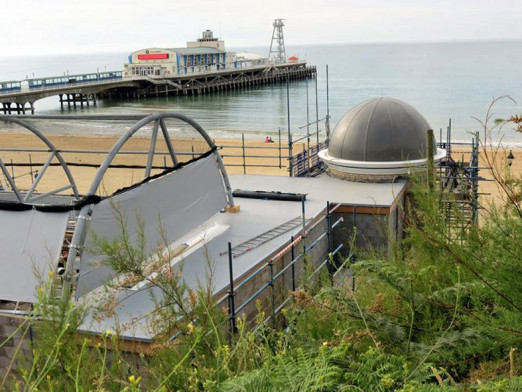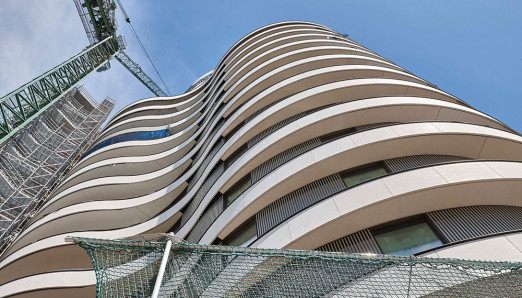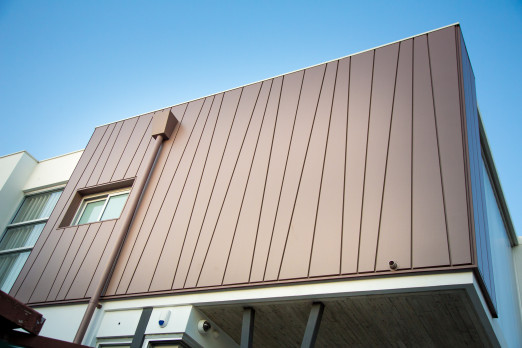Designing roofing with multiple materials is very satisfying but it can be a challenge in terms of risk. SIG Design & Technology look at what you can do to execute your design vision with honesty to materials and still achieve a robust, efficient outcome.
Benefits of using Multiple Material Roofs
When we are designing a roof, it isn’t always the case that a single material or system will tick all the boxes, even when the roof form is relatively simple. Using multiple materials can help us deal with our design needs.
- Aesthetic – in many situations we want to create complex roof structures as part of an aesthetic design decision. Perhaps we want to combine flat and pitched roof elements, curves and angles, or include unusual edge details to tie in with an overall design approach.
- Appearance – following along from the modernist ‘form follows function’ mantra, we may want to tie the appearance of each roof area to the material it is made of, using the materials which suit each roof element. For example, we may wish to use tiles, slate or metals on pitched roofs, and membranes or liquids on flat areas. Alternatively, contrasting roofing materials may contribute to our wish to contrast roof forms in a more postmodernist approach.
- Cost Efficiency – We may wish to use relatively costly materials in areas where they will be highly visible, such as a metal cladding to a façade or curved area and apply relatively lower cost materials where they won’t be seen but can perform as well or better.
Some materials lend themselves to multiple use. For example, single ply roofing membranes work well as an alternative to copper, zinc or lead on pitched roofs, and schemes with a mixture of flat and pitched roofs could therefore be single material. However, notwithstanding the cost issues, our aesthetic sensibilities encourage us to be more honest with materials for a better, more holistic outcome. When the project comes to be executed, this can cause us problems.
The Problems of Complex Interfaces
When we want to design roofs with multiple materials, the challenge arises as to how the interfaces will be designed, executed and guaranteed. Here’s a common scenario.
- Your team has designed a roof with a number of materials and in between them are a number of interfaces – zinc to liquids, slate to membranes, liquids to membranes, for example.
- The nature of roof design is such that often the choice of build-up and detail design is carried out in conjunction with a manufacturer of the materials, but many manufacturers only have expertise in one or a small group of products, for example membranes, and are only in a position to detail their own products. In some cases, several contractors will be necessary as well.
- Because of the inexperience of manufacturers in complex interface design between different materials, detailing can be difficult. The very points of greatest need, the interfaces, become the place where the least care and the least experience is applied. When the project is completed, you end up with beautiful roofs with nasty little details.
- Predictably, we find that no one manufacturer or contractor is willing or able to take responsibility for interface design, which increases risk to all parties, and in particular to the design team and their client. If there is a failure, the fall out can descend into a blame game between designer, contractors and manufacturers. Ultimately the client suffers and so does your insurance.
A Professional Approach to Multi Material Roof Design
SIG Design and Technology are not a manufacturer, we are a supplier who offers a range of roofing materials from membranes and hot and cold applied liquids, to green and blue roofs, metal roofing and cladding and pitched roofing materials such as tiles and natural slate and stone. Our supply chain is backed up by SIG Plc, a FTSE 250 listed company.
We are also experienced designers, accreditors and inspectors of roofing design and construction with our own Professional Indemnity Insurance and our own accredited contractors. Here’s how we can help your team reduce risk on multi material roofs.
Designing Complex Interfaces
We have technical experts in all sorts of materials, who routinely work together to develop solutions to multi material interfaces. We also take responsibility for the interface design, allowing the architect the freedom to choose whatever she or he wants to use. Don’t restrict your imagination based on the lack of availability of specialist support.
U Value Calculations and Condensation Risk Analysis
Complex roof constructions can have complex needs for energy performance and condensation prevention, not just at the interfaces. If several manufacturers provide calculations for their own elements, you may end up falling between stools. We can provide calculations and analysis for all the different roofing systems from one source, giving you a uniform answer that is more reliable.
Wind Uplift Calculations
Wind uplift risk is very much about the edges of roofs. SIG Design and Technology have a reputation for being very thorough with their wind uplift and rainwater calculations. This reduces the risk of a roof system failing due to insufficient fixings, inadequate gutters or overflows or upstands being too shallow.
Cut to Falls Insulation
Cut to Falls schemes are also part of the service; we can supply a comprehensive survey of your roof if required, together with design and manufacture of a bespoke cut to falls system which avoids ponding water on roofs. With refurbishment projects, our consultants will always attend on site to carry out a survey to ensure that no inconsistencies are overlooked.
We have also tested the membranes we supply to ensure that adhered membranes (which are commonly used) are reliable.
Acoustics calculations
We work with acousticians regularly, partly due to our experience with schools where there are specific acoustic standards to meet. The acoustician produces the acoustic requirement and our technicians then develop a specification for the roof to meet that requirement.
Your building usage may require a silent or near silent interior environment which could benefit from this expertise. For example, we recently designed the roof of a media centre at a cricket ground where journalists are often broadcasting when rain stops play and therefore insisted that rain noise was eliminated.
Accredited Installation with Inspections
Good details are only good if they are executed well. We work with some of the best roofing contractors in the country through our DATAC Accredited Contractor Scheme. This scheme ensures that the roofing contractors that install the products we supply are trained, competent and are continually honing their skills. DATAC contractors’ work is inspected on site to ensure that their work is consistently of a high standard. Our contractors take pride in their work, and we are proud of our partnership with them.
Full System Warranties
With multiple material roofs the risk is multiplied. Not only due to the interfaces but simple due to many products and many installers from many different companies. On a multi-product roof system, we can unify the responsibilities and cover it with one guarantee. We can also design to the SIG One Warranty Scheme. Don’t get into arguments between different material suppliers – instead obtain a single warranty to cover and protect the designer as well as the client.
Take a Professional Approach
A professional approach to multi-material roof design allows the architect to achieve their design vision with beautiful interfaces, expertly detailed and executed, at no additional cost to that of the materials.
Get in touch if you think we can help on your project.
Image: Jersey Evening Post.









